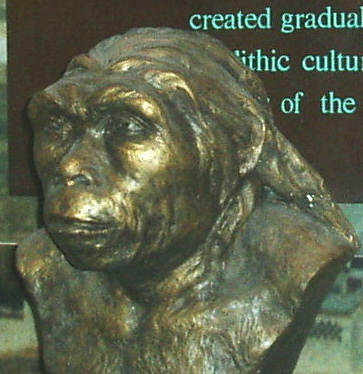- Lantian Man
Taxobox
name = Lantian Man
fossil_range =Pleistocene

image_caption = Lantian Man, Reconstruction in theShaanxi History Museum , Xian (taken in March 2006)
regnum =Animal ia
phylum = Chordata
subphylum = Vertebrata
classis =Mammal ia
ordo =Primates
familia =Hominidae
genus = "Homo"
species = "H. erectus"
subspecies = "H. e. lantianensis"
trinomial = "Homo erectus lantianensis"
trinomial_authority = (J.K.Woo,1964 )Lantian Man ("
Homo erectus lantianensis", formerly "Sinanthropus lantianensis") was an ancestral human. Its discovery in 1963 was first described by J.K. Woo the following year.Remnants of Lantian Man (called Lantian Ren; 蓝田人 in Chinese) were found in
Lantian County (蓝田县; pinyin: Lántián Xiàn), inChina 's northwesternShaanxi province, approximately 50 km southeast of the city ofXi'an . Shortly after the discovery of themandible (jaw bone) of the first Lantian Man atChenjiawo (陈家窝), also in Lantian County, acranium (skull) with nasal bones, right maxilla, and three teeth of another specimen of Lantian Man were found atGongwangling (公王岭), another site in Lantian County.The cranial capacity is estimated to be 780 cubic cm (48 cubic inches), somewhat similar to that of its contemporary,
Java Man .Lantian Man is older than the better-known
Peking Man (240,000–400,000 BCE), but possibly younger thanYuanmou Man , who according to some estimates may have lived about 1.7 million years ago in modern-day China.These fossils are believed to come from two females who lived about 530,000 to 1 million years ago, the second being the older one by about 400,000 years. Gongwangling Man represents the oldest fossil of an erect human ever found in northern Asia. Scientists classify Lantian Man as a
subspecies of "Homo erectus ". The fossils are displayed at theShaanxi History Museum ,Xi'an , China.In the same strata as and close to the Lantian Man fossils, animal
fossils and stone artifacts were found, such as treated pebbles and flakes. The presence of these stone artifacts and as well as ashes suggests that Lantian Man used tools and could control fire.Repository
* [http://www.ivpp.ac.cn/ Institute of Vertebrate Paleontology and Paleoanthropology] (IVPP), Beijing, China.
References
* Woo, J., 1964. Mandible of "Sinanthropus lantianensis". Curr. Anthropol. 5, 98-101.
* Woo, J., 1965. Preliminary report on a skull of "Sinanthropus lantianensis" of Lantian, Shensi. Sci. Sin. 14.
* Woo, J., 1966. The skull of Lantian Man. Curr. Anthropol. 5, 83-86.* Woo JK. A newly discovered mandible of the Sinanthropus type – Sinanthropus lantianensis. Sci. Sin. 13:801-11,1964.
* Aigner JS, Laughlin WS. The Dating of Lantian Man and His Significance for Analyzing trends in Human Evolution. Am J Phys Anthrop 39:97-110, 1973. PMID 4351579External links
* [http://www-personal.une.edu.au/~pbrown3/.htm Dr. Peter Brown's Webpage]
* [http://www.chinaculture.org/gb/en_artqa/2003-09/24/content_39044.htm China Culture]
* [http://www.silkroadguide.com/xian/xian5.htm Shaanxi History Museum]
Wikimedia Foundation. 2010.
